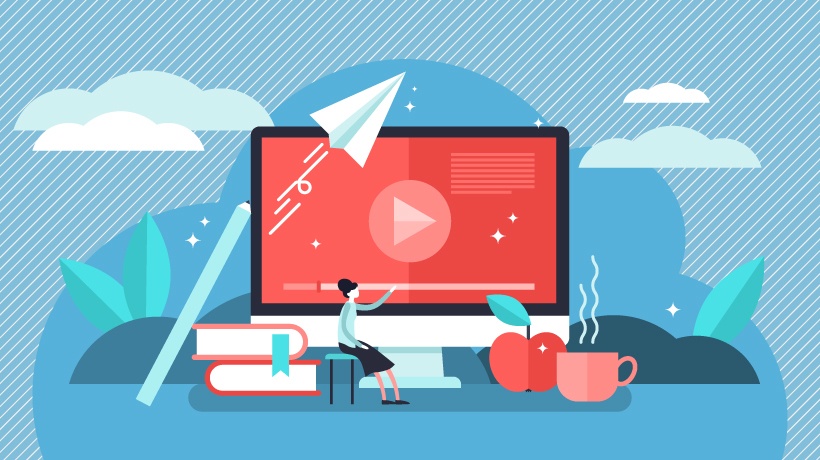How To Use Videos In eLearning During COVID-19
It was a typical weekday in March. The weather was warm and the school grounds were empty. Students, though, were not in school. In fact, the schools closed until further notice due to the COVID-19 pandemic. Scientists and governments promised a vaccine or cure at the earliest. But if history is any sign, a workable vaccine for COVID-19 could take at least 18 months. The authorities had no other choice but to impose severe restrictions on movement.
All citizens had to follow home quarantine and there was talk that it could take months before the situation improves. The unprecedented situation created by the pandemic has spared no one. Doctors singled out and labeled the elderly and children below 10 years as most vulnerable. Adults are worried about losing jobs and lack of stable income in the future.
Our future generation studying in schools and colleges is also affected by closures due to COVID-19. More than a billion students in 186 countries are staring at an uncertain future. Even if the situation improves in a few months, few parents would be willing to risk sending their kids to schools and colleges where it’s difficult to practice social distancing.
Video Courses To The Rescue
eLearning technologies that not too long ago were developing at a snail’s pace are now pushed to the forefront to combat the education crisis due to COVID-19. We know the classroom system works because it has been in use for centuries; tried, tested, and reformed only a million times.
Online learning software and platforms are relying on videos to make eLearning an effective support system or an alternative to classroom learning. You can hardly imagine an eLearning program without videos.
Videos will soon attract more than 80% of all web traffic, and pedagogy experts believe it’s better to show than tell a skill. Text and images are so impersonal and lifeless. eLearning without videos will miss the human element. It will fail to create the teacher-student relationship that’s so crucial to the classroom environment.
Today, let’s find out how to use videos in eLearning during the COVID-19 crisis.
1. Short Videos Are Better
Take inspiration from how our brains absorb information that we learn—small chunks at a time. Similarly, create short instructional videos that are not more than 10 minutes long. Segmenting lessons into bit-sized videos helps the students pay attention to the full video, easily digest the information, and retain the lessons for a long time. Dividing a topic into segments and making multiple videos enable the viewers to link new to the existing knowledge.
Cramming several pieces of information in a single video might lead to cognitive overload. The students end up learning very little in the process. Furthermore, the students might eventually lose interest in the topic itself. If making long eLearning videos becomes unavoidable, make the lectures interactive, or include trivia breaks to give students time to process the information.
2. Make the Videos Interactive
Again, we stress upon cognitive overload that can derail effective learning in any scenario, be it online or offline. There are many ways to keep the students interested and engaged with the videos. The first method is already practiced by the best teachers around the world—add context to the instructions.
The ultimate objective of adding interactivity is to encourage the students to reflect, analyze, and learn. You can keep the learners interested by connecting instructions with real-life scenarios. Real-life examples, stories, and graphics are easy to relate, memorize, and recall.
The second best method is to challenge learners and adopt a mistake-driven learning approach. Even a 5-minute monologue can be tough to get through for most learners. At intervals, challenge the memory and understanding of the students by introducing small tasks that trigger their interest and curiosity.
In a classroom environment, most students stay silent because of their fear of making mistakes. eLearning provides the perfect platform to use the mistake-driven learning approach. Encourage students to learn from mistakes, and try again and again till they fully understand the concept that’s being taught.
The purpose of adding interactivity in eLearning videos is to prevent learners from becoming mere spectators. Finally, at the end of the video or session, encourage students to share their feedback and concerns. Dealing with feedback in a constructive manner without being judgmental can help students learn better.
3. Consider The Quality Of The Videos
Every company that introduces electronic devices nowadays promises crystal-clear display and high-definition picture quality. Do we need eLearning courses in 4k resolution? No, but videos must be good enough to see and understand all the visual and graphic elements in it. Furthermore, avoid jerky motion and coding errors; video errors like these can be distracting to the learners.
Equally important is the quality of the audio. Unclear voice or distracting background noise will undermine the effectiveness of the video and impact the whole learning experience. Poor sound quality can affect the focus and attention span of the learners. So, use a decent microphone to record audio and also ensure the learners have quality headphones or speakers.
If the eLearning videos are prerecorded then editing assumes special significance. When it comes to eLearning videos, less is definitely more. To increase the impact of the instructions, remove footage deemed as excess and unnecessary by the instructor. Bear in mind that editing the video should not affect the flow of the lecture. If your organization has the budget, you may want to consider using video editing services to make your product look more polished.
4. Compress The File Size without Affecting The Video Quality
While more people are jumping on the internet bandwagon around the world, the internet speeds aren’t increasing as expected. In the eLearning industry, slow internet speed affects both course creators and students.
Schools and colleges that are planning live lecture sessions need to factor download speed at the student’s end as well. Households that do not have high-speed internet connections will have a tough time availing of the service during the COVID-19 lockdown.
Moreover, creating and uploading video files that stream without buffering requires digital infrastructure, which is an unplanned expenditure for schools and colleges. Pixilated images and slow loading videos affect students’ concentration and experience.
We’ve already talked about creating short videos for easy assimilation of information. Short videos also mean smaller file sizes that are easier and quicker to upload and download.
Apart from smaller file sizes, eLearning video creators need to compress the files before uploads. Naturally, you might be wondering how compressing will affect the video and sound quality. It depends on the compressing software used to accomplish the task. If you use the best tools available, it’s possible to reduce the file size by 20% to 30% without losing the quality.
5. Provide Formatted Transcript
Some teachers assume that learners will remember everything that they say. It’s not so. If we want the students to remember what’s being taught in the eLearning courses, they must be able to see and hear the lessons. This can be achieved by adding a transcript of the video.
An equally good reason to use transcripts is that it promotes learning offline. After the video lecture session is over, students need not re-watch the video again to find a particular piece of information. A well-formatted transcript with sub-headings, short paragraphs, and bullet points will greatly benefit the students.
Transcripts can benefit both teachers and students. eLearning course instructors can use the transcripts to prepare additional content and also frame questions for student evaluation. In addition, they can use it to prepare infographics and animation to make education even more interesting and engaging.
The natural curiosity and innovative ability of students allow them to repurpose the transcripts in a number of ways. In their hands, long transcripts can turn into diagrams, charts, guides, etc. for later reference.
6. Develop Multi-Platform eLearning Videos
Until the COVID-19 crisis blows over, we can safely assume that most students are confined to their homes. Although internet connectivity has reached a large percentage of households, inside the house, it takes multiple avatars.
Not every household has a desktop computer. Some prefer using laptops for eLearning courses. Plus, smartphones and tablets allow students to watch educational videos anywhere.
Bear in mind, video formats that work with laptops might not run in smartphones. Formats that are not compatible with all devices will lead to a poor experience for the students. To be safe, create or convert videos to multiple formats or use a format (example: MP4 format) that performs well on all devices, including laptop, mobile, etc. eLearning video creators should check font, alignment, navigation controls, and performance of the videos on multiple platforms before releasing the course.
Final Thoughts
If there was ever a field waiting for innovation and disruption, it’s none other than the field of education. The digitalization of classrooms is the way forward or at least for the foreseeable future. Videos play a disproportionately large role in eLearning and in the process of disseminating knowledge among the students. So, use these 6 tips to create effective videos for online lessons.










